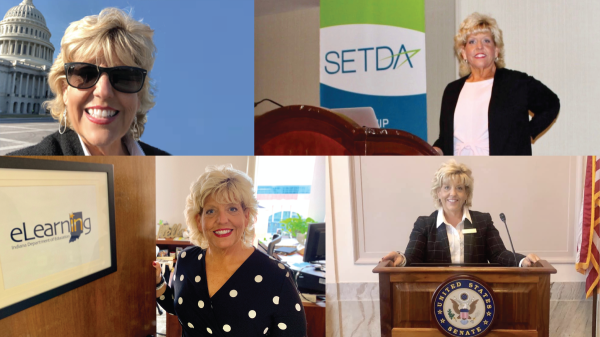At SETDA, personalized learning is a story of innovations — and big hurdles

Educators say they are getting closer to the day when personalized learning will be the rule, rather than the exception, in American schools. But state education leaders gathered this week outside Washington also see stubborn obstacles to achieving that vision, including long-standing requirements for education funding, classroom attendance and standardized tests, as well as widespread gaps in internet access in rural communities.
Technology gaps are part of the problem. While 88 percent of U.S. schools now have robust Wi-Fi in their classrooms, more than 2,000 rural K-12 schools are still cut off from digital learning infrastructure, and another 10,000 schools are still in need of upgrades, according to a report released last month by the nonprofit EducationSuperHighway.
Education and technology leaders in more than a dozen states, from Alaska to Wyoming, continue to look for novel ways to close the internet gap, cobbling together public and private partner alliances to bring fiber and Wi-Fi infrastructure to rural schools and communities.
Among the more innovative ventures presented at a State Educational Technology Directors Association summit this week is Microsoft’s Rural Airband Initiative.
Microsoft wants to get owners of unused TV white space spectrum — in the 600 MHz frequency band — to repurpose it to bring high-speed broadband to many rural parts of America that have to rely on poor cable connections, radio-powered modems and even satellite technology, according to Melissa Sassi, program manager of Microsoft Airband Initiative.
Sassi said the initiative has already led to a pilot program in Charlotte County, Virginia, as part of a broader aim to invest in partnerships with telecommunications companies to create 12 projects in 12 states over the next 12 months.
“What’s important about rural access,” however, said SETDA Executive Director Tracy Weeks, “isn’t just access to the internet, but access to high-quality teachers. It’s hard to recruit teachers out to these districts.” Connecting well-qualified teachers to students in rural areas can make a significant difference in education and economic opportunity for students, their families and entire communities, she said.
When it comes to advances in personalized learning, however, technology solutions still often aren’t enough to overcome long-entrenched requirements that dictate when and how long students must attend school, how their progress is assessed and how schools more broadly qualify for funding, based on those requirements, according to edtech leaders speaking at the forum.
States need to do a better job of empowering administrators and teachers and communicating how best to adopt personalized learning, said Sarah Young, coordinator for digital teaching and learning at the Utah State Board of Education
“Don’t tell us what we can’t do. Tell me what I can do,” said Young. “If we take that role as state leaders, and say, ‘Here are the resources to take those steps,’ that is one of the ways we keep our [teachers] — but also create the environment where others want to be part of that.”
Avril Smart, research and engagement manager for Future Ready Schools at the Alliance for Excellent Education, said another crucial ingredient to personalized learning lies in states allowing school districts more latitude to determine school curricula and who should decide what is taught. She cited how Rutherford County, North Carolina, a once-thriving textile manufacturing center that had fallen on hard times, had reinvented its economy by developing personalized learning programs for students and adults in the community.
Vermont is another state seeing the benefits of personalized learning leadership, according to Sigrid Olson, personalized learning coordinator for the Vermont Agency of Education.
“We have taken away a lot of the barriers to personalized learning,” she said, thanks to state legislation known as Act 77, that went into effect this year, requiring schools to provide personalized learning for all students across the state.
“What I like about personalized learning in Vermont is, it is very student-centered,” she said. She stressed, however, that the initiative also relies on student agency and a focus on proficiency-based progress. She also credited school leaders for “removing barriers and creating innovative spaces” within schools to promote personalized learning.




